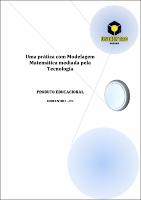| Compartilhamento |


|
Use este identificador para citar ou linkar para este item:
http://tede.unicentro.br:8080/jspui/handle/jspui/1453Registro completo de metadados
| Campo DC | Valor | Idioma |
|---|---|---|
| dc.creator | Chulek, Carina | - |
| dc.creator.Lattes | http://lattes.cnpq.br/3507334531754347 | por |
| dc.contributor.advisor1 | Veronez, Michele Regiane Dias | - |
| dc.contributor.advisor1Lattes | http://lattes.cnpq.br/4294737927701301 | por |
| dc.date.accessioned | 2021-03-26T19:18:38Z | - |
| dc.date.issued | 2020-03-03 | - |
| dc.identifier.citation | Chulek, Carina. Produção de (Signos) Interpretantes Mediada pela Tecnologia em Atividades de Modelagem Matemática. 2020. 80 f. Dissertação (Programa de Pós-Graduação em Ensino de Ciências Naturais e Matemática - Mestrado Profissional) - Universidade Estadual do Centro-Oeste, Guarapuava-PR. | por |
| dc.identifier.uri | http://tede.unicentro.br:8080/jspui/handle/jspui/1453 | - |
| dc.description.resumo | Nesta investigação assumimos a Modelagem Matemática como uma alternativa pedagógica que proporciona aos alunos abordarem situações-problema de sua realidade ou do seu interesse. Neste contexto, a Modelagem Matemática é uma alternativa que proporciona aos alunos condições para aprender Matemática, bem como, adquirir conhecimentos de outras áreas e utilizar-se de ferramentas do seu ambiente, como os softwares. É no desenvolvimento de atividades de modelagem matemática que a busca por soluções para problemas acontece, mesmo que tais problemas tenham sido enunciados pelos alunos, pelo professor, ou por um acordo entre ambos, temos por objetivo analisar os signos produzidos pelos alunos ao longo de atividades de modelagem matemática desenvolvidas a partir de imagens e com recorrência ao GeoGebra, e que tiveram seus problemas por eles propostos. Para discutir acerca desses (signos) interpretantes, apresentamos duas atividades de modelagem matemática desenvolvidas por alunos de um 1º ano de Ensino Médio, de uma escola privada, do município de Pitanga – Paraná. A questão que orienta nossa investigação: que signos são produzidos nas atividades de modelagem matemática desenvolvidas a partir de imagens e com recorrência ao GeoGebra? é, contudo, analisada segundo aportes da metodologia qualitativa, tanto na coleta como na análise, e no tratamento dos dados. Como resultados ponderamos que os interpretantes produzidos pelos alunos no decorrer das atividades de modelagem matemática por eles desenvolvidas revelam (des)conhecimentos matemáticos e extramatemáticos. Além disso, tais interpretantes provocam nos alunos reflexões sobre os conhecimentos emergidos e por eles construídos ou mobilizados e favorecem geração de novos signos. Também, as ações e encaminhamentos tomados pelosalunos no decorrer de cada uma das atividades de modelagem matemática, associadas aos signos por eles produzidos, viabilizam com que eles superem dificuldades relacionadas ao fazer Modelagem Matemática e construam conhecimentos relativos ao GeoGebra, à Matemática e à situação em estudo. | por |
| dc.description.abstract | In this investigation, we assume Mathematical Modeling as a pedagogical alternative that allows students to approach problem situations of their reality or interest. In this context, Mathematical Modeling is an alternative that provides students with conditions to learn mathematics, as well as acquire knowledge from other areas and use tools from their environment, such as software. It is in the development of mathematical modeling activities that the search for solutions to problems occurs, this search that may have been enunciated by the students, by the teacher, or by an agreement between both, we aim to analyze the signs produced by the students during activities of mathematical modeling developed from images and with recurrence to GeoGebra, and which had their problems proposed by them. To discuss these interpretative (signs), we present two activities of mathematical modeling developed by students of a 1st year of High School, from a private school, in the municipality of Pitanga - Paraná. The question that guides our investigation is: which signs are produced and in the activities of mathematical modeling are developed from the images, with the recurrence. As a result we consider that the interpretantes produced by the students during the course of the activities of the mathematical modeling undertaken by it, reveal the (in) knowledge of the mathematical and non-mathematical. In addition to this, these interpretants elicit students ' reflections on the insights which have emerged, and why they are built or deployed and lead to the generation of new signs. Also, the actions and directions taken by the students during the course of each and every one of the activities of the mathematical modeling, are associated with the signs that they have been produced, enable them overcome the difficulties related to the making of Mathematical Modeling and to build up knowledge on the GeoGebra, in the Mathematics, and the situation at hand. | eng |
| dc.description.provenance | Submitted by Fabiano Jucá (fjuca@unicentro.br) on 2021-03-26T19:18:38Z No. of bitstreams: 2 Dissertação - Carina Chulek.pdf: 3583136 bytes, checksum: 608f297cb679f249d1cd6f65a32bb11b (MD5) Produto Educacional - Carina_Chulek.pdf: 2586539 bytes, checksum: d495172320cb84b5fbf462046f55340d (MD5) | eng |
| dc.description.provenance | Made available in DSpace on 2021-03-26T19:18:38Z (GMT). No. of bitstreams: 2 Dissertação - Carina Chulek.pdf: 3583136 bytes, checksum: 608f297cb679f249d1cd6f65a32bb11b (MD5) Produto Educacional - Carina_Chulek.pdf: 2586539 bytes, checksum: d495172320cb84b5fbf462046f55340d (MD5) Previous issue date: 2020-03-03 | eng |
| dc.description.sponsorship | Coordenação de Aperfeiçoamento de Pessoal de Nível Superior - CAPES | por |
| dc.format | application/pdf | * |
| dc.thumbnail.url | http://tede.unicentro.br:8080/jspui/retrieve/5606/Disserta%c3%a7%c3%a3o%20-%20Carina%20Chulek.pdf.jpg | * |
| dc.thumbnail.url | http://tede.unicentro.br:8080/jspui/retrieve/5608/Produto%20Educacional%20-%20Carina_Chulek.pdf.jpg | * |
| dc.thumbnail.url | http://tede.unicentro.br:8080/jspui/retrieve/5610/Disserta%c3%a7%c3%a3o%20-%20Carina%20Chulek.pdf.jpg | * |
| dc.thumbnail.url | http://tede.unicentro.br:8080/jspui/retrieve/5612/Produto%20Educacional%20-%20Carina_Chulek.pdf.jpg | * |
| dc.language | por | por |
| dc.publisher | Universidade Estadual do Centro-Oeste | por |
| dc.publisher.department | Unicentro::Departamento de Biologia | por |
| dc.publisher.department | Unicentro::Departamento de Matemática | por |
| dc.publisher.department | Unicentro::Departamento de Química | por |
| dc.publisher.department | Unicentro::Departamento de Física | por |
| dc.publisher.department | Unicentro::Departamento de Ciências Agrárias e Ambientais | por |
| dc.publisher.department | Unicentro::Departamento de Ciências Exatas e de Tecnologia | por |
| dc.publisher.country | Brasil | por |
| dc.publisher.initials | UNICENTRO | por |
| dc.publisher.program | Programa de Pós-Graduação em Ensino de Ciências Naturais e Matemática (Mestrado Profissional) | por |
| dc.rights | Acesso Aberto | por |
| dc.subject | Modelagem Matemática | por |
| dc.subject | Semiótica | por |
| dc.subject | Tecnologia | por |
| dc.subject | Interpretantes | por |
| dc.subject | Mathematical Modeling | eng |
| dc.subject | Semiotics | eng |
| dc.subject | Technology | eng |
| dc.subject | Interpretants | eng |
| dc.subject.cnpq | EDUCACAO::ENSINO-APRENDIZAGEM | por |
| dc.subject.cnpq | MATEMATICA::MATEMATICA APLICADA | por |
| dc.subject.cnpq | OUTROS::CIENCIAS | por |
| dc.title | Produção de (Signos) Interpretantes Mediada pela Tecnologia em Atividades de Modelagem Matemática | por |
| dc.title.alternative | Interpretant (Sign) Production Mediated by Technology in Mathematical Modeling Activities | eng |
| dc.type | Dissertação | por |
| Aparece nas coleções: | Programa de Pós-Graduação em Ensino de Ciências Naturais e Matemática | |
Arquivos associados a este item:
| Arquivo | Descrição | Tamanho | Formato | |
|---|---|---|---|---|
| Dissertação - Carina Chulek.pdf | Carina Chulek | 3,5 MB | Adobe PDF |  Baixar/Abrir Pré-Visualizar |
| Produto Educacional - Carina_Chulek.pdf | Produto Educacional - Carina_Chulek | 2,53 MB | Adobe PDF |  Baixar/Abrir Pré-Visualizar |
Os itens no repositório estão protegidos por copyright, com todos os direitos reservados, salvo quando é indicado o contrário.




